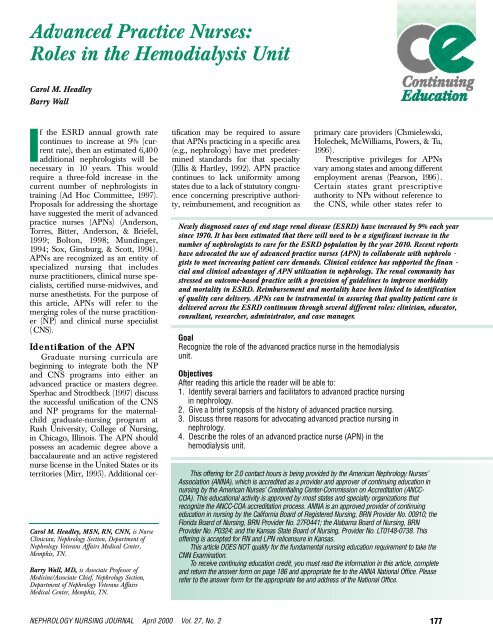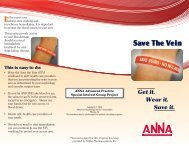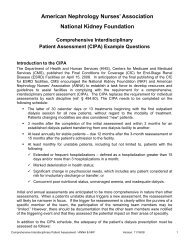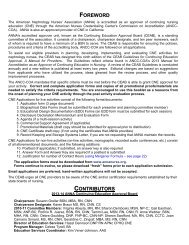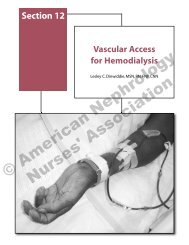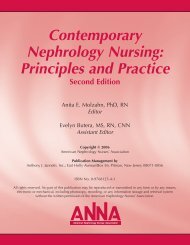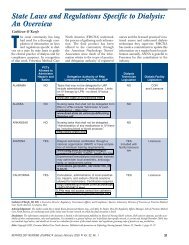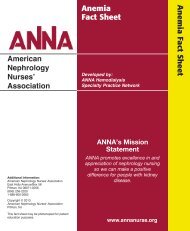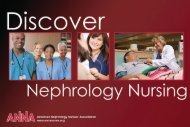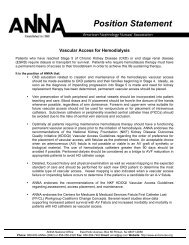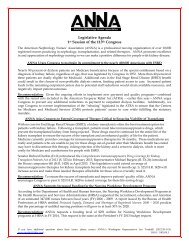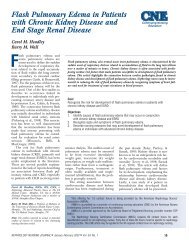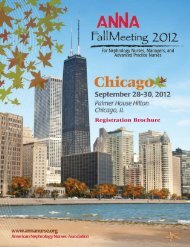Advanced Practice Nurses: Roles in the Hemodialysis Unit
Advanced Practice Nurses: Roles in the Hemodialysis Unit
Advanced Practice Nurses: Roles in the Hemodialysis Unit
Create successful ePaper yourself
Turn your PDF publications into a flip-book with our unique Google optimized e-Paper software.
<strong>Advanced</strong> <strong>Practice</strong> <strong>Nurses</strong>:<br />
<strong>Roles</strong> <strong>in</strong> <strong>the</strong> <strong>Hemodialysis</strong> <strong>Unit</strong><br />
Carol M. Headley<br />
Barry Wall<br />
If <strong>the</strong> ESRD annual growth rate<br />
cont<strong>in</strong>ues to <strong>in</strong>crease at 9% (current<br />
rate), <strong>the</strong>n an estimated 6,40 0<br />
additional nephrologists will be<br />
necessary <strong>in</strong> 10 years. This would<br />
require a three-fold <strong>in</strong>crease <strong>in</strong> <strong>the</strong><br />
current number of nephrologists <strong>in</strong><br />
tra<strong>in</strong><strong>in</strong>g (Ad Hoc Committee, 1997 ) .<br />
Proposals for address<strong>in</strong>g <strong>the</strong> shortage<br />
have suggested <strong>the</strong> merit of advanced<br />
practice nurses (APNs) (Anderson,<br />
Torres, Bitter, Anderson, & Briefel,<br />
1999; Bolton, 1998; Mund<strong>in</strong>ger,<br />
1994; Sox, G<strong>in</strong>sburg, & Scott, 1994 ) .<br />
A PNs are recognized as an entity of<br />
specialized nurs<strong>in</strong>g that <strong>in</strong>cludes<br />
nurse practitioners, cl<strong>in</strong>ical nurse specialists,<br />
certified nurse-midwives, and<br />
nurse anes<strong>the</strong>tists. For <strong>the</strong> purpose of<br />
this article, APNs will refer to <strong>the</strong><br />
merg<strong>in</strong>g roles of <strong>the</strong> nurse practitioner<br />
(NP) and cl<strong>in</strong>ical nurse specialist<br />
( CNS).<br />
Id e n t i fication of <strong>the</strong> APN<br />
Graduate nurs<strong>in</strong>g curricula are<br />
beg<strong>in</strong>n<strong>in</strong>g to <strong>in</strong>tegrate both <strong>the</strong> NP<br />
and CNS programs <strong>in</strong>to ei<strong>the</strong>r an<br />
advanced practice or masters degree.<br />
Sperhac and Strodtbeck (1997) discuss<br />
<strong>the</strong> successful unification of <strong>the</strong> CNS<br />
and NP programs for <strong>the</strong> maternalchild<br />
graduate-nurs<strong>in</strong>g program at<br />
Rush University, College of Nu r s i n g ,<br />
<strong>in</strong> Chicago, Ill<strong>in</strong>ois. The APN should<br />
possess an academic degree above a<br />
baccalaureate and an active registered<br />
nurse license <strong>in</strong> <strong>the</strong> <strong>Unit</strong>ed States or its<br />
territories (Mirr, 1995). Additional cer-<br />
Carol M. Headley, MSN, RN, CNN, is Nurse<br />
Cl<strong>in</strong>ician, Nephrology Section, Department of<br />
Nephrology Veterans Affairs Medical Center,<br />
Memphis, TN.<br />
Barry Wall, MD, is Associate Professor of<br />
Medic<strong>in</strong>e/Associate Chief, Nephrology Section,<br />
Department of Nephrology Veterans Affairs<br />
Medical Center, Memphis, TN.<br />
tification may be required to assure<br />
that APNs practic<strong>in</strong>g <strong>in</strong> a specific area<br />
(e.g., nephrology) have met predeterm<strong>in</strong>ed<br />
standards for that specialty<br />
(Ellis & Hartley, 1992). APN practice<br />
cont<strong>in</strong>ues to lack uniformity among<br />
states due to a lack of statutory congruence<br />
concern<strong>in</strong>g prescriptive authority,<br />
reimbursement, and recognition as<br />
primary care providers (Chmielewski,<br />
Ho l e chek, McWilliams, Powers, & Tu ,<br />
1996 ) .<br />
Prescriptive privileges for APN s<br />
vary among states and among different<br />
employment arenas (Pearson, 1996 ) .<br />
Certa<strong>in</strong> states grant prescriptive<br />
authority to NPs without reference to<br />
<strong>the</strong> CNS, while o<strong>the</strong>r states refer to<br />
Newly diagnosed cases of end stage renal disease (ESRD) have <strong>in</strong>creased by 9% each year<br />
s<strong>in</strong>ce 1970. It has been estimated that <strong>the</strong>re will need to be a significant <strong>in</strong>crease <strong>in</strong> <strong>the</strong><br />
number of nephrologists to care for <strong>the</strong> ESRD population by <strong>the</strong> year 2010. Recent reports<br />
have advocated <strong>the</strong> use of advanced practice nurses (APN) to collaborate with nephrolo -<br />
gists to meet <strong>in</strong>creas<strong>in</strong>g patient care demands. Cl<strong>in</strong>ical evidence has supported <strong>the</strong> f<strong>in</strong>an -<br />
cial and cl<strong>in</strong>ical advantages of APN utilization <strong>in</strong> nephrology. The renal community has<br />
stressed an outcome-based practice with a provision of guidel<strong>in</strong>es to improve morbidity<br />
and mortality <strong>in</strong> ESRD. Reimbursement and mortality have been l<strong>in</strong>ked to identification<br />
of quality care delivery. APNs can be <strong>in</strong>strumental <strong>in</strong> assur<strong>in</strong>g that quality patient care is<br />
delivered across <strong>the</strong> ESRD cont<strong>in</strong>uum through several different roles: cl<strong>in</strong>ician, educator,<br />
consultant, researcher, adm<strong>in</strong>istrator, and case manager.<br />
G o a l<br />
Recognize <strong>the</strong> role of <strong>the</strong> advanced practice nurse <strong>in</strong> <strong>the</strong> hemodialysis<br />
u n i t .<br />
O b j e c t i v e s<br />
After read<strong>in</strong>g this article <strong>the</strong> reader will be able to:<br />
1. Identify several barriers and facilitators to advanced practice nurs<strong>in</strong>g<br />
<strong>in</strong> nephrology.<br />
2. Give a brief synopsis of <strong>the</strong> history of advanced practice nurs<strong>in</strong>g.<br />
3. Discuss three reasons for advocat<strong>in</strong>g advanced practice nurs<strong>in</strong>g <strong>in</strong><br />
n e p h r o l o g y.<br />
4. Describe <strong>the</strong> roles of an advanced practice nurse (APN) <strong>in</strong> <strong>the</strong><br />
hemodialysis unit.<br />
This offer<strong>in</strong>g for 2.0 contact hours is be<strong>in</strong>g provided by <strong>the</strong> American Nephrology <strong>Nurses</strong>’<br />
Association (ANNA), which is accredited as a provider and approver of cont<strong>in</strong>u<strong>in</strong>g education <strong>in</strong><br />
nurs<strong>in</strong>g by <strong>the</strong> American <strong>Nurses</strong>’ Credential<strong>in</strong>g Center-Commission on Accreditation (ANCC-<br />
COA). This educational activity is approved by most states and specialty organizations that<br />
recognize <strong>the</strong> ANCC-COA accreditation process. ANNA is an approved provider of cont<strong>in</strong>u<strong>in</strong>g<br />
education <strong>in</strong> nurs<strong>in</strong>g by <strong>the</strong> California Board of Registered Nurs<strong>in</strong>g, BRN Provider No. 00910; <strong>the</strong><br />
Florida Board of Nurs<strong>in</strong>g, BRN Provider No. 27F0441; <strong>the</strong> Alabama Board of Nurs<strong>in</strong>g, BRN<br />
Provider No. P0324; and <strong>the</strong> Kansas State Board of Nurs<strong>in</strong>g, Provider No. LT0148-0738. This<br />
offer<strong>in</strong>g is accepted for RN and LPN relicensure <strong>in</strong> Kansas.<br />
This article DOES NOT qualify for <strong>the</strong> fundamental nurs<strong>in</strong>g education requirement to take <strong>the</strong><br />
CNN Exam<strong>in</strong>ation.<br />
To receive cont<strong>in</strong>u<strong>in</strong>g education credit, you must read <strong>the</strong> <strong>in</strong>formation <strong>in</strong> this article, complete<br />
and return <strong>the</strong> answer form on page 186 and appropriate fee to <strong>the</strong> ANNA National Office. Please<br />
refer to <strong>the</strong> answer form for <strong>the</strong> appropriate fee and address of <strong>the</strong> National Office.<br />
NEPHROLOGY NURSING JOURNAL April 2000 Vol. 27, No. 2 177
oth as a “midlevel provider.”<br />
Restrictions for APNs range from limit<strong>in</strong>g<br />
prescriptive selection to a specified<br />
formulary, to co-signature requirement<br />
by a physician (MD) for controlled<br />
substances, to no prescriptive<br />
provision (Pearson, 1996). The lack of<br />
a uniform regulatory body for APNs is<br />
recognized as an obstacle to def<strong>in</strong><strong>in</strong>g<br />
<strong>the</strong> cl<strong>in</strong>ical role of APNs, particularly<br />
<strong>in</strong> regards to prescriptive authority<br />
(Chmielewski et al., 1996 ) .<br />
A PN recognition and reimbursement<br />
as a primary care provider<br />
( PCP) are often discussed simultaneo<br />
u s l y. A PCP is one who assumes<br />
<strong>in</strong>dependent responsibility for a provided<br />
service and contracts with a<br />
hospital or agency for pay (Be y e r s ,<br />
Gunn, Egg<strong>in</strong>g, & Thomas, 1997). In<br />
contrast, collaborative practice<br />
<strong>in</strong>volves physician oversight and<br />
many states base reimbursement on<br />
<strong>the</strong> type of practices (collaborative vs.<br />
<strong>in</strong>dependent). Currently, 13 states<br />
and <strong>the</strong> District of Columbia reimburse<br />
NPs without physician collaboration<br />
(Ventura, 1998). Barriers still<br />
exist for APNs, but substantial<br />
progress has been made over <strong>the</strong> past<br />
25 years.<br />
A PN Historical Pe r s p e c t i ve s<br />
Nearly 25 years ago, both <strong>the</strong> government<br />
and private sector recognized<br />
<strong>the</strong> need for APNs to assist with <strong>in</strong>tensify<strong>in</strong>g<br />
health care demands. The<br />
Department of Health, Education, and<br />
Welfare established an <strong>in</strong>terdiscipl<strong>in</strong>ary<br />
committee to exam<strong>in</strong>e <strong>the</strong><br />
expand<strong>in</strong>g role of nurses <strong>in</strong> health<br />
care. These f<strong>in</strong>d<strong>in</strong>gs gave impetus for<br />
federal fund<strong>in</strong>g of graduate nurs<strong>in</strong>g<br />
programs (Kitzman, 1983). Ad v a n c e d<br />
practice degrees were emphasized <strong>in</strong><br />
ambulatory care sett<strong>in</strong>gs and were limited<br />
to adult, obstetric, and pediatric<br />
primary care. Certified nurse midwives<br />
and certified registered nurse<br />
anes<strong>the</strong>tists were del<strong>in</strong>eated separately<br />
because of <strong>the</strong>ir unique practice.<br />
<strong>Advanced</strong> practice specialization <strong>in</strong><br />
o<strong>the</strong>r cl<strong>in</strong>ical areas emerged <strong>in</strong> <strong>the</strong><br />
1990s (Berger et al., 1996 ) .<br />
The need for nephrology APN s<br />
was recognized almost 25 years ago<br />
even though specialized tra<strong>in</strong><strong>in</strong>g was<br />
178<br />
not yet available. Shapiro (1976 )<br />
designed a program to assist dialysis<br />
nurses <strong>in</strong> return<strong>in</strong>g to school for an<br />
advanced practice degree <strong>in</strong> 1976 .<br />
After obta<strong>in</strong><strong>in</strong>g academic credentials,<br />
additional tra<strong>in</strong><strong>in</strong>g related to <strong>the</strong><br />
unique needs of <strong>the</strong> nephrology<br />
patients was offered. These APN s<br />
were subsequently employed <strong>in</strong> satellite<br />
dialysis units. Ne p h r o l o g i s t s<br />
directly supervised APNs, such that<br />
any prescribed <strong>the</strong>rapy by an APN<br />
required a physician co-signature.<br />
Fiscal analysis demonstrated economic<br />
benefit, s<strong>in</strong>ce each APN assisted <strong>in</strong><br />
manag<strong>in</strong>g 50 chronic dialysis patients<br />
at a cost significantly below that<br />
w h i ch physicians would <strong>in</strong>cur<br />
(Shapiro, 1976).<br />
Today’s cost-conserv<strong>in</strong>g climate of<br />
health care has focused on <strong>the</strong> economic<br />
impact of us<strong>in</strong>g APNs to provide<br />
some services given by MD s<br />
( Berger et al., 1996). The sav<strong>in</strong>gs<br />
would be largely due to salary differentials,<br />
with <strong>the</strong> APN be<strong>in</strong>g paid less<br />
than <strong>the</strong> MD. Cost sav<strong>in</strong>gs of APN s<br />
has not been limited to salary differentials,<br />
as APNs have been reported<br />
to prescribe less expensive but equally<br />
effective diagnostic or <strong>the</strong>rapeutic<br />
<strong>in</strong>terventions than MDs (Salkever,<br />
Sk<strong>in</strong>ner, Ste<strong>in</strong>wachs, & Katz, 1982 ) .<br />
Kassirer (1994) disputes this f<strong>in</strong>d<strong>in</strong>g<br />
and suggests that APNs do not order<br />
sophisticated diagnostic tests (e.g.,<br />
magnetic resonance imag<strong>in</strong>g) because<br />
of <strong>the</strong>ir lack of familiarity with <strong>the</strong>se<br />
tests and that this may jeopardize<br />
patient care. Bolton (1998) confirms<br />
<strong>the</strong> economic benefit of APNs <strong>in</strong><br />
nephrology and emphasizes additional<br />
APN qualities <strong>in</strong>clud<strong>in</strong>g: subspecialty<br />
expertise, competency, flexibility,<br />
and positive patient reception.<br />
Today, some APNs are able to function<br />
as PCPs and have established<br />
nurse managed cl<strong>in</strong>ics, reimbursed at<br />
<strong>the</strong> same rates as physicians (Ve n t u r a ,<br />
1998 ) .<br />
A PN Me r i t<br />
The proposed shortage of available<br />
nephrologists to care for <strong>the</strong> grow<strong>in</strong>g<br />
ESRD population is a significant<br />
<strong>in</strong>centive for APN sanction.<br />
Nephrologists have reported spend<strong>in</strong>g<br />
38% of <strong>the</strong>ir total ESRD practice time<br />
devoted to primary care (Bender &<br />
Holley, 1996). A recent outcomebased<br />
study that compared NPs to<br />
MDs <strong>in</strong> a ambulatory care sett<strong>in</strong>g concluded<br />
that primary care provided by<br />
NPs was equal to that of MDs. NP s<br />
ma<strong>in</strong>ta<strong>in</strong>ed <strong>the</strong> same authority and<br />
responsibilities delegated to <strong>the</strong>ir MD<br />
counterparts, with random patient<br />
assignments (Mund<strong>in</strong>ger et al., 20 0 0 ) .<br />
Most nephrologists spend a significant<br />
proportion of <strong>the</strong>ir time <strong>in</strong> <strong>the</strong> care of<br />
non-ESRD patients (Ad Hoc<br />
Committee, 1997). APNs have been<br />
advocated <strong>in</strong> <strong>the</strong> management of<br />
patients pre-ESRD as well as <strong>in</strong> <strong>the</strong><br />
care of dialysis patients, allow<strong>in</strong>g<br />
nephrologists to have a more diversified<br />
practice (Bolton, 1998). Bolton<br />
( 1998) described a successful collaborative<br />
practice model utiliz<strong>in</strong>g a NP <strong>in</strong><br />
<strong>the</strong> care of pre-ESRD and ESRD<br />
patients. Collaborative practice<br />
between a MD and APN is comprised<br />
of jo<strong>in</strong>t commitments to patient care<br />
with an <strong>in</strong>tegration of talents and skills<br />
(Chmielewski et al., 1996).<br />
Nephrology APNs <strong>in</strong> a collaborative<br />
practice ma<strong>in</strong>ta<strong>in</strong> a great deal of autonomy<br />
<strong>in</strong> provid<strong>in</strong>g primary care with<br />
support from nephrologists for specific<br />
needs (e.g., admitt<strong>in</strong>g privileges) that<br />
<strong>the</strong> APN may not be able to provide<br />
(Ste<strong>in</strong>man, 1999 ) .<br />
The <strong>Unit</strong>ed States Renal Data<br />
System (USRDS) reports an annual<br />
death rate of approximately 25%<br />
(higher than any <strong>in</strong>dustrialized country)<br />
for ESRD. Age and comorbid illnesses<br />
modify <strong>in</strong>dividual mortality<br />
rates (Agodoa, Wolfe, & Port, 1999 ) .<br />
European nephrologists have suggested<br />
that American nephrologists spend<br />
less time with patients and that this<br />
may be a factor <strong>in</strong> <strong>the</strong> higher mortality<br />
rates (Suki, 1999). With <strong>the</strong> predicted<br />
shortage of nephrologists over <strong>the</strong> next<br />
10 years, nephrologists will have less<br />
time with <strong>in</strong>dividual patients; such<br />
decreased patient contact time could<br />
adversely affect patient mortality.<br />
Bolton (1998) made a comparative<br />
analysis of nephrologists and NPs <strong>in</strong><br />
reference to time spent with patients.<br />
The average pages/calls received by<br />
<strong>the</strong> NP was twice that of nephrologists<br />
NEPHROLOGY NURSING JOURNAL April 2000 Vol. 27, No. 2
per month. Patients called NPs first for<br />
m<strong>in</strong>or illnesses because <strong>the</strong> NP was<br />
perceived as more sympa<strong>the</strong>tic and<br />
will<strong>in</strong>g to allot more time to address<br />
<strong>the</strong>ir needs (Bolton, 1998). A Ne w<br />
York dialysis unit recently conducted a<br />
survey to f<strong>in</strong>d out nurses’ perceptions<br />
of an APN colleague. APN availability<br />
and accountability for dialysis orders,<br />
emergency evaluations, and preventive<br />
and health ma<strong>in</strong>tenance were considered<br />
to be <strong>the</strong> most valuable contributions<br />
of APNs. APN availability was<br />
considered to be an improvement<br />
over orders written by <strong>the</strong> nephrologist<br />
that rotated through <strong>the</strong> unit on a<br />
monthly basis (Izzo, 1982 ) .<br />
Debate cont<strong>in</strong>ues over <strong>the</strong> care of<br />
dialysis patients by APNs as compared<br />
to physician assistants (PA). An<br />
editorial by Suki (1999) explored<br />
n e p h r o l o g i s t /PA collaborative practice<br />
issues, but never identified APN s<br />
as a possible alternative. Retention of<br />
<strong>in</strong>ternational nephrology fellows and<br />
recruitment of medical school graduates<br />
<strong>in</strong>to <strong>the</strong> nephrology subspecialty<br />
were considered preferred alternatives<br />
to address<strong>in</strong>g <strong>the</strong> shortage of<br />
nephrologists (Suki, 1999). Ach i e v ement<br />
of <strong>the</strong>se proposals is not likely<br />
when <strong>the</strong>re is a lack of evidence for a<br />
change <strong>in</strong> current trends.<br />
Conservative estimates of ESRD<br />
prevalence rates and workforce<br />
requirements still estimate a significant<br />
shortage of nephrologists <strong>in</strong> 10<br />
years (Ad Hoc Committee, 1997 ) .<br />
Numerous authors, however, have<br />
supported <strong>the</strong> utilization of NPs over<br />
PAs <strong>in</strong> collaborative practice agreements<br />
(Beyers et al., 1997; Bolton,<br />
1998; Sox et al., 1994). NPs were recommended<br />
over PAs because NP s<br />
were thought to require less supervision<br />
than PAs (Bolton, 1998; Sox et<br />
al., 1994) and were considered to<br />
have more direct patient care experience<br />
(Ventura, 1998). Watts and<br />
Chmielewski conducted a survey of<br />
nephrology APNs with 45 respondents;<br />
<strong>the</strong> majority possessed over 10<br />
years of nurs<strong>in</strong>g experience (as cited<br />
<strong>in</strong> Chmielewski et al., 1996). To d a y ,<br />
NPs (20.7%) outnumber PAs (8.9%)<br />
<strong>in</strong> collaborative practice with<br />
nephrologists (Anderson et al., 1999 ) .<br />
Consider<strong>in</strong>g <strong>the</strong> complex nature of<br />
patients with ESRD, cl<strong>in</strong>ical experience<br />
is essential to provid<strong>in</strong>g quality<br />
c a r e .<br />
ESRD patients’ unique <strong>in</strong>terrelated<br />
considerations <strong>in</strong>clude adequacy of<br />
dialysis, management of anemia, electrolyte<br />
disturbances, renal osteodystrophy,<br />
access patency, dietary considerations,<br />
treatment of comorbid conditions,<br />
and rehabilitative <strong>in</strong>itiatives.<br />
Kassirer (1994) noted that NPs were<br />
rated superior to physicians <strong>in</strong> patient<br />
satisfaction and <strong>in</strong> patient compliance<br />
with health promotion and ma<strong>in</strong>tenance,<br />
but ma<strong>in</strong>ta<strong>in</strong>ed a lack of support<br />
for APNs as PCPs. Mund<strong>in</strong>ger<br />
( 1994) considered diagnosis and treatment<br />
by NPs and physicians to be simi<br />
l a r. NPs, however, were more likely to<br />
expand treatment to <strong>in</strong>clude patient<br />
education, counsel<strong>in</strong>g, and health<br />
ma<strong>in</strong>tenance <strong>in</strong>terventions. The nature<br />
and perpetuity of diseases/impairments<br />
affect<strong>in</strong>g ESRD patients (e.g.,<br />
hypertension, renal osteodystrophy,<br />
anemia, electrolyte imbalances)<br />
require cont<strong>in</strong>uous <strong>the</strong>rapeutic monitor<strong>in</strong>g<br />
to assure adequate management<br />
(Daugirdas, 1994 ) .<br />
The Department of Veterans<br />
Affairs issued a policy promot<strong>in</strong>g<br />
employment of APNs because it was<br />
felt that APNs could effectively manage<br />
up to 80% of patient care requirements<br />
(Ventura, 1998). Experienced<br />
A PNs <strong>in</strong> <strong>the</strong> hemodialysis unit should<br />
be able to successfully address <strong>the</strong><br />
majority of patient care issues, but<br />
<strong>the</strong>ir practice may best be conveyed <strong>in</strong><br />
collaboration with one or more<br />
nephrologists. A major barrier to<br />
nephrologists acceptance of APNs is<br />
related to quality of care concerns<br />
( Beyers et al., 1997). Lack of clarity <strong>in</strong><br />
def<strong>in</strong><strong>in</strong>g APN roles has led to concerns<br />
among both nurses and physicians<br />
regard<strong>in</strong>g competency (Chmielewski<br />
et al., 1996). The American Nu r s e s ’<br />
Association has def<strong>in</strong>ed a graduate<br />
level degree as a requirement for identification<br />
of APNs (American Nu r s e s ’<br />
Association, 1996).<br />
A PN <strong>in</strong> <strong>the</strong> <strong>Hemodialysis</strong> Un i t<br />
The follow<strong>in</strong>g section will address<br />
roles of APNs <strong>in</strong> <strong>the</strong> care of<br />
hemodialysis patients, emphasiz<strong>in</strong>g<br />
utilization of a collaborative team<br />
a p p r o a ch which <strong>in</strong>cludes, nephrologist,<br />
dietician, social worker, psych o lo<br />
g i s t / p s y chiatrist, vascular access surgeon,<br />
<strong>in</strong>terventional radiologist, dialysis<br />
nurse, and APN .<br />
Ma<strong>in</strong>ta<strong>in</strong><strong>in</strong>g effective communication<br />
among all members of <strong>the</strong> team<br />
is essential to quality care, and <strong>the</strong><br />
A PN must assume a pivotal role. It is<br />
difficult to separate APN roles (cl<strong>in</strong>ician,<br />
educator, consultant, counselor,<br />
adm<strong>in</strong>istrator, and research e r )<br />
because of <strong>the</strong>ir overlapp<strong>in</strong>g nature.<br />
Some APNs function as adm<strong>in</strong>istrators<br />
and o<strong>the</strong>rs practice as case managers,<br />
hav<strong>in</strong>g 24-hour accountability<br />
for patients <strong>in</strong> <strong>the</strong> caseload (Berger et<br />
al., 1996). This article will explore <strong>the</strong><br />
A PN as a cl<strong>in</strong>ician, educator, consultant,<br />
and research e r. A scenario will<br />
be given for each role to illustrate<br />
A PN <strong>in</strong>volvement and emphasize <strong>the</strong><br />
need for a collaborative practice.<br />
Cl i n i c i a n<br />
Nephrology APNs <strong>in</strong>stitute treatment<br />
options for a variety of patient<br />
problems and <strong>in</strong>itiate preventive<br />
measures to avert development of<br />
complications. <strong>Hemodialysis</strong> patients<br />
are subject to unique problems not<br />
often observed with o<strong>the</strong>r chronic illnesses.<br />
Hematological, nutritional,<br />
endocr<strong>in</strong>e, musculoskeletal, and<br />
immune response abnormalities are<br />
just a few of <strong>the</strong> universal problems<br />
associated with chronic dialysis <strong>the</strong>rapy<br />
(Daugirdas, 1994). There is a predom<strong>in</strong>ance<br />
of cardiovascular disease<br />
<strong>in</strong> <strong>the</strong> ESRD population, such that<br />
chronic renal failure has been<br />
described as a vasculopathic state<br />
(Luke, 1998). Cardiovascular disease<br />
has been identified as <strong>the</strong> cause of up<br />
to 50% of deaths <strong>in</strong> ESRD (Ritz &<br />
Querfeld, 1986), with cardiac arrests,<br />
acute myocardial <strong>in</strong>farction, and cardiac<br />
arrhythmia account<strong>in</strong>g for one<br />
third of all ESRD deaths (Luke,<br />
1998). Hypertension and diabetes<br />
mellitus account for <strong>the</strong> cause of<br />
approximately two thirds of ESRD<br />
cases. Because of <strong>the</strong> magnitude of<br />
<strong>the</strong> problem of cardiovascular disease,<br />
nephrology practice must <strong>in</strong>cor-<br />
NEPHROLOGY NURSING JOURNAL April 2000 Vol. 27, No. 2 179
porate treatment of all modifiable cardiac<br />
risk factors. Modifiable risk factors<br />
<strong>in</strong>clude smok<strong>in</strong>g cessation,<br />
improved hypertension, diabetes<br />
mellitus, and hyperlipidemia treatment.<br />
Additional modifiable factors<br />
unique to renal failure <strong>in</strong>clude management<br />
of secondary hyperparathyroidism<br />
and anemia. Abnormal calcium<br />
and phosphorus metabolism have<br />
been associated with <strong>the</strong> development<br />
of vascular calcifications and<br />
a<strong>the</strong>rosclerotic heart disease (Block ,<br />
Hulbert-Shearon, Lev<strong>in</strong>, & Po r t ,<br />
1998; Rostand, Sanders, Kathar<strong>in</strong>e,<br />
Rutsky, & Fraser, 1988; Terman et al.,<br />
1971). Recent cl<strong>in</strong>ical evidence has<br />
concluded that <strong>the</strong> relative risk of<br />
death for hemodialysis patients is significantly<br />
greater for those with a<br />
hematocrit less than 30% (Co l l i n s ,<br />
Ma, Xia, & Ebben, 1997). This<br />
<strong>in</strong>creased attention to cardiovascular<br />
risk factors fur<strong>the</strong>r expands <strong>the</strong> role of<br />
<strong>the</strong> nephrology team as primary care<br />
providers. The APN can provide<br />
valuable <strong>in</strong>put <strong>in</strong>to <strong>the</strong> day-to-day<br />
management of each of <strong>the</strong>se risk fact<br />
o r s .<br />
The renal community has placed<br />
emphasis on aggressive disease management<br />
to address <strong>the</strong> high mortality<br />
risks of ESRD. The National Kidney<br />
Foundation Dialysis Outcomes Quality<br />
Initiative Cl<strong>in</strong>ical <strong>Practice</strong> Guidel<strong>in</strong>es<br />
have given support to <strong>the</strong> establishment<br />
of certa<strong>in</strong> expectations of care for<br />
ESRD patients (National Kidney<br />
Foundation, 1997). Reimbursement <strong>in</strong>itiatives<br />
for dialysis have associated<br />
accountability for quality of care<br />
(Hannah, Lev<strong>in</strong>, London, & Osheroff,<br />
1999). Evidence-based medic<strong>in</strong>e has<br />
documented that implementation of<br />
cl<strong>in</strong>ical practice guidel<strong>in</strong>es can reduce<br />
mortality and improve quality of life<br />
( National Kidney Foundation, 1997 ) .<br />
The ability to adequately manage all of<br />
<strong>the</strong> cl<strong>in</strong>ical aspects of hemodialysis<br />
patients may be monumental for a<br />
nephrologist with a diversified practice.<br />
An APN <strong>in</strong> <strong>the</strong> hemodialysis unit that<br />
possesses critical th<strong>in</strong>k<strong>in</strong>g, advanced<br />
knowledge, and expert skills may facilitate<br />
implementation of cl<strong>in</strong>ical practice<br />
guidel<strong>in</strong>es and, <strong>the</strong>refore, effect an<br />
improved patient quality of life.<br />
180<br />
The APN will often refer patients<br />
for treatment or diagnostic procedures.<br />
APNs may also be tra<strong>in</strong>ed to<br />
perform certa<strong>in</strong> <strong>in</strong>vasive procedures<br />
(transplant kidney biopsies, femoral<br />
and <strong>in</strong>ternal jugular ca<strong>the</strong>ter placements).<br />
Anderson and colleagues<br />
( 1999) reported that out of 53 surveyed<br />
PAs, 35% rout<strong>in</strong>ely perform<br />
femoral cannulization and 5.7% performed<br />
<strong>in</strong>ternal jugular/subclavian<br />
ve<strong>in</strong> cannulizations. In <strong>the</strong> first<br />
author’s experience, <strong>the</strong> number of<br />
A PNs do<strong>in</strong>g procedures was not identified<br />
<strong>in</strong> this study, but APNs have<br />
been acknowledged <strong>in</strong> provid<strong>in</strong>g temporary<br />
access placement <strong>in</strong> several<br />
dialysis units. APNs have been del<strong>in</strong>eated<br />
as access coord<strong>in</strong>ators for all<br />
identified problems (Ste<strong>in</strong>man, 1999 ) ,<br />
w h i ch should <strong>in</strong>clude provision of<br />
temporary access. APNs have been<br />
reported as possess<strong>in</strong>g as much skill<br />
as physicians <strong>in</strong> <strong>the</strong> performance of<br />
specific <strong>in</strong>vasive procedures<br />
(Kassirer, 1994). Ma<strong>in</strong>ta<strong>in</strong><strong>in</strong>g vascular<br />
accesses for chronic dialysis patients<br />
is a frequent cause for patient hospitalization<br />
and is attributed to <strong>the</strong> high<br />
costs of ESRD care (Hannah et al.,<br />
1999). Often, a patient will present to<br />
<strong>the</strong> dialysis unit with a thrombosed or<br />
<strong>in</strong>fected access and require hospitalization.<br />
APNs may be able to<br />
decrease associated costs by provid<strong>in</strong>g<br />
temporary vascular access, allow<strong>in</strong>g<br />
for un<strong>in</strong>terrupted dialysis while<br />
coord<strong>in</strong>at<strong>in</strong>g fur<strong>the</strong>r treatment on an<br />
outpatient basis. If <strong>the</strong> access is determ<strong>in</strong>ed<br />
to pose an immediate threat<br />
(e.g., <strong>in</strong>fection), <strong>the</strong>n hospitalization is<br />
u n a v o i d a b l e .<br />
A PNs may be <strong>in</strong>strumental <strong>in</strong><br />
expedit<strong>in</strong>g vascular access placement,<br />
allow<strong>in</strong>g time necessary for maturity<br />
prior to beg<strong>in</strong>n<strong>in</strong>g chronic dialysis. It<br />
has been recommended that an arteriovenous<br />
fistula be constructed 4<br />
months before <strong>the</strong> need for dialysis<br />
(Hannah et al., 1999). Contact with<br />
<strong>the</strong> vascular surgeon may be delayed<br />
for many reasons. An APN may be<br />
able to make a prelim<strong>in</strong>ary exam<strong>in</strong>ation<br />
that would expedite care.<br />
Dim<strong>in</strong>ished peripheral pulses place a<br />
patient at <strong>in</strong>creased risk for isch e m i a<br />
(hand or foot) once an access is con-<br />
structed, or an identified umbilical<br />
hernia may <strong>in</strong>dicate <strong>the</strong> need for surgical<br />
repair prior to Te n ck h o f f<br />
ca<strong>the</strong>ter placement and <strong>in</strong>itiation of<br />
peritoneal dialysis. Recognition of<br />
<strong>the</strong>se f<strong>in</strong>d<strong>in</strong>gs on physical exam<strong>in</strong>ation<br />
and coord<strong>in</strong>at<strong>in</strong>g treatment will<br />
avoid possible delays <strong>in</strong> access placement.<br />
Patients with a history of central<br />
venous ca<strong>the</strong>ters may require<br />
venography prior to arteriovenous fistula<br />
or arteriovenous graft surgery<br />
( Schwab et al., 1988). The APN can<br />
often assist <strong>the</strong> vascular access surgeon<br />
<strong>in</strong> obta<strong>in</strong><strong>in</strong>g necessary presurgical<br />
evaluations. Cont<strong>in</strong>uous monitor<strong>in</strong>g<br />
of access parameters and close<br />
communication with dialysis nurses<br />
will allow <strong>the</strong> APN to coord<strong>in</strong>ate necessary<br />
radiographic study and treatment<br />
of identifiable stenosis with<br />
angioplasty, stent placement, or surgical<br />
revision.<br />
The acute and chronic hemodialysis<br />
unit based <strong>in</strong> a hospital sett<strong>in</strong>g may<br />
allow APNs opportunities (e.g., performance<br />
of <strong>in</strong>vasive procedures)<br />
thwarted by satellite cl<strong>in</strong>ics. APN s<br />
who perform procedures must realize<br />
that certa<strong>in</strong> risks are associated with<br />
any <strong>in</strong>vasive procedure and know<br />
what measures to be taken if complications<br />
arise. Certa<strong>in</strong> advantages exist<br />
for those units that employ an APN<br />
skilled <strong>in</strong> <strong>the</strong> placement of ca<strong>the</strong>ters<br />
for acute dialysis. Femoral ve<strong>in</strong><br />
ca<strong>the</strong>ter placement for temporary<br />
access <strong>in</strong> a chronic dialysis patient<br />
with a thrombosed vascular access<br />
may obviate <strong>the</strong> need for central l<strong>in</strong>e<br />
placement prior to access thrombolysis<br />
or surgical thrombectomy. In<br />
many circumstances, <strong>the</strong> APN can<br />
offer valuable skill <strong>in</strong> perform<strong>in</strong>g procedures<br />
that have less associated risk<br />
than alternative treatments. Two scenarios<br />
will be presented to demonstrate<br />
<strong>the</strong> cl<strong>in</strong>ical role of an APN <strong>in</strong> an<br />
acute and chronic hemodialysis unit<br />
based <strong>in</strong> a primary care hospital.<br />
A PN cl<strong>in</strong>ical scenario 1. A 64 -<br />
year-old chronic dialysis patient presented<br />
for his regular treatment compla<strong>in</strong><strong>in</strong>g<br />
of chest pa<strong>in</strong> and palpitations.<br />
He had a past history of recurrent<br />
paroxysmal supraventricular<br />
t a chycardia (PSVT), but no history of<br />
NEPHROLOGY NURSING JOURNAL April 2000 Vol. 27, No. 2
coronary artery disease. His PS V T<br />
had been treated with multiple antiarrhythmic<br />
agents <strong>in</strong>clud<strong>in</strong>g digox<strong>in</strong><br />
0 .125 mg every o<strong>the</strong>r day and verapamil<br />
240 mg every day. His <strong>in</strong>itial<br />
vital signs <strong>in</strong>cluded heart rate of 168<br />
beats/m<strong>in</strong>ute, blood pressure 140 / 72<br />
mmHg, and a respiratory rate of<br />
22/m<strong>in</strong>ute. The patient was given<br />
oxygen and placed on a cardiac monitor,<br />
which confirmed <strong>the</strong> presence of<br />
paroxysmal supraventricular tach ycardia.<br />
Blood was obta<strong>in</strong>ed for rout<strong>in</strong>e<br />
chemistries and for levels of<br />
digox<strong>in</strong> and verapamil. After conferr<strong>in</strong>g<br />
with <strong>the</strong> on-call nephrologist, a<br />
total of 5 mg of <strong>in</strong>travenous verapamil<br />
was adm<strong>in</strong>istered. This resulted<br />
<strong>in</strong> no change <strong>in</strong> heart rate, however,<br />
blood pressure decreased to 110 / 60<br />
mmHg. After phone consultation<br />
with <strong>the</strong> on-call cardiologist, adenos<strong>in</strong>e<br />
(6 mg) was adm<strong>in</strong>istered <strong>in</strong>trav<br />
e n o u s l y. This was accompanied by<br />
an abrupt term<strong>in</strong>ation of <strong>the</strong> PS V T<br />
with return of normal s<strong>in</strong>us rhythm.<br />
Initial laboratory evaluation confirmed<br />
<strong>the</strong> presence of <strong>the</strong>rapeutic<br />
blood levels of digox<strong>in</strong> and verapamil.<br />
Given <strong>the</strong> symptomatic nature<br />
of <strong>the</strong> PSVT and its refractor<strong>in</strong>ess to<br />
standard anti-arrhythmic <strong>the</strong>rapy, <strong>the</strong><br />
patient underwent electrophysiologic<br />
studies with surgical ablation of a reentrant<br />
pathway. He has subsequently<br />
been able to discont<strong>in</strong>ue all antiarrhythmics<br />
without recurrence of<br />
PS V T. In this case, <strong>the</strong> data collected<br />
by <strong>the</strong> APN dur<strong>in</strong>g <strong>the</strong> acute arrhythmia<br />
(documentation of symptoms,<br />
vital signs, blood levels of antiarrhythmic<br />
agents, electrocardiac<br />
monitor trac<strong>in</strong>gs confirm<strong>in</strong>g <strong>the</strong><br />
PSVT, and conversion with adenos<strong>in</strong>e)<br />
were <strong>the</strong> critical data used to<br />
document <strong>the</strong> need for surgical ablative<br />
<strong>the</strong>rapy <strong>in</strong> this patient.<br />
A PN cl<strong>in</strong>ical scenario 2. A 74 -<br />
year-old man with ESRD receiv<strong>in</strong>g<br />
hemodialysis presented for his sch e duled<br />
dialysis treatment and was found<br />
to have a thrombosed brach i o a x i l l a r y<br />
arteriovenous graft. Initial evaluation<br />
of <strong>the</strong> graft <strong>in</strong>dicated no evidence of<br />
<strong>in</strong>fection. Laboratory f<strong>in</strong>d<strong>in</strong>gs <strong>in</strong>cluded<br />
serum potassium of 6.2 mEq/L .<br />
He was 5.4 kg above his established<br />
dry weight and had a history of recurrent<br />
pulmonary edema due to<br />
i s chemic cardiomyopathy. These<br />
f<strong>in</strong>d<strong>in</strong>gs confirmed <strong>the</strong> need for<br />
urgent dialysis. Femoral ve<strong>in</strong><br />
ca<strong>the</strong>ters were placed by <strong>the</strong> APN to<br />
permit immediate dialysis. The APN<br />
relayed <strong>the</strong> access history to <strong>the</strong> <strong>in</strong>terventional<br />
radiologist who sch e d u l e d<br />
<strong>the</strong> patient to have graft thrombolysis<br />
<strong>the</strong> follow<strong>in</strong>g day. The patient had a<br />
history of prior thrombosis of this<br />
access associated with a significant<br />
stenosis of <strong>the</strong> brachiocephalic ve<strong>in</strong>,<br />
w h i ch had been previously angioplastied.<br />
The vascular access surgeon and<br />
<strong>in</strong>terventional radiologist were both<br />
consulted by <strong>the</strong> APN to determ<strong>in</strong>e<br />
<strong>the</strong> optimal treatment option to salvage<br />
<strong>the</strong> patient’s present access<br />
because of limited availability of alternative<br />
access sites.<br />
A prophylactic treatment plan was<br />
discussed with <strong>the</strong> <strong>in</strong>terventional radiologist<br />
regard<strong>in</strong>g <strong>the</strong> patient’s history<br />
of allergy to radiocontrast media. The<br />
patient was currently resid<strong>in</strong>g <strong>in</strong> a<br />
nurs<strong>in</strong>g home, requir<strong>in</strong>g <strong>the</strong> APN to<br />
communicate with <strong>the</strong> nurs<strong>in</strong>g home<br />
staff and to write orders for <strong>the</strong> management<br />
of <strong>the</strong> patient, which <strong>in</strong>cluded:<br />
(a) keep<strong>in</strong>g <strong>the</strong> patient <strong>in</strong> bed for<br />
<strong>the</strong> next 4 hours, (b) observ<strong>in</strong>g <strong>the</strong><br />
right gro<strong>in</strong> pressure dress<strong>in</strong>g for any<br />
signs of bleed<strong>in</strong>g or development of<br />
hematoma hourly for 4 hours and<br />
record<strong>in</strong>g, (c) giv<strong>in</strong>g 30 mg prednisone<br />
po at 9 p.m. tonight and <strong>in</strong> <strong>the</strong><br />
a.m., (d) giv<strong>in</strong>g 50 mg diphenhydram<strong>in</strong>e<br />
<strong>in</strong> <strong>the</strong> a.m., and e) provid<strong>in</strong>g<br />
a clear liquid breakfast <strong>in</strong> a.m. The<br />
patient was brought to <strong>the</strong> <strong>in</strong>terventional<br />
radiological suite, as directed,<br />
and had successful thrombolysis of<br />
his access with percutaneous translum<strong>in</strong>al<br />
angioplasty of <strong>the</strong> brach i ocephalic<br />
ve<strong>in</strong> stenosis without complic<br />
a t i o n s .<br />
This complicated patient was<br />
managed successfully as an outpatient,<br />
even though he was currently<br />
resid<strong>in</strong>g <strong>in</strong> a nurs<strong>in</strong>g home. This case<br />
emphasizes <strong>the</strong> complexity of management<br />
of thrombosed vascular<br />
accesses, which cont<strong>in</strong>ues to be <strong>the</strong><br />
most common <strong>in</strong>dication for hospitalization<br />
and surgical <strong>in</strong>tervention <strong>in</strong><br />
chronic hemodialysis patients. The<br />
possible avoidance of hospitalization<br />
and associated expenditures is an<br />
example of <strong>the</strong> economic benefits of<br />
<strong>the</strong> availability of an APN who is<br />
tra<strong>in</strong>ed to perform temporary vascular<br />
access for acute dialysis.<br />
E d u c a t o r<br />
A PNs <strong>in</strong> <strong>the</strong> hemodialysis unit<br />
have a responsibility for staff and<br />
patient education. Patient education is<br />
imperative at <strong>the</strong> pre-ESRD level of<br />
patient care. Many patients do not<br />
receive adequate <strong>in</strong>formation regard<strong>in</strong>g<br />
dialysis access, such as <strong>the</strong> need to<br />
preserve arm ve<strong>in</strong>s for future vascular<br />
access (Hannah et al., 1999). Early<br />
education has <strong>the</strong> potential to avert<br />
long-term access problems and<br />
reduce costs (Schwab et al., 1998 ) .<br />
Patient selection of a dialysis modality<br />
should also be given adequate time<br />
to <strong>in</strong>sure selection of <strong>the</strong> most appropriate<br />
dialysis modality. An APN can<br />
assist <strong>the</strong> patient and family <strong>in</strong> mak<strong>in</strong>g<br />
this critical decision.<br />
The realization of <strong>the</strong> impend<strong>in</strong>g<br />
need for chronic dialysis may be<br />
overwhelm<strong>in</strong>g to patients and families.<br />
The APN can alleviate this anxiety<br />
by educat<strong>in</strong>g <strong>the</strong> patient and family<br />
about <strong>the</strong> requirements and expectations<br />
that accompany chronic dialysis<br />
<strong>the</strong>rapy. Medications and dietary<br />
changes differ depend<strong>in</strong>g on dialysis<br />
m o d a l i t y. The APN can highlight<br />
<strong>the</strong>se differences, allow<strong>in</strong>g patients<br />
<strong>the</strong> opportunity for a more <strong>in</strong>formed<br />
decision. The APN must communicate<br />
with <strong>the</strong> dietician regard<strong>in</strong>g <strong>the</strong><br />
patient’s cultural dietary preferences<br />
that may impact dialysis modality<br />
selection (e.g., vegetarians with a relatively<br />
low dietary prote<strong>in</strong> <strong>in</strong>take may<br />
not thrive on peritoneal dialysis).<br />
A PNs may recognize <strong>the</strong> need for<br />
early social worker <strong>in</strong>volvement if<br />
cultural obstacles and economic disadvantages<br />
exist that would impact<br />
<strong>the</strong> transition to chronic dialysis.<br />
A PNs may also assess discussions<br />
concern<strong>in</strong>g transplant <strong>in</strong>terest and<br />
candidacy at <strong>the</strong> pre-ESRD level of<br />
c a r e .<br />
Patient compliance can be directly<br />
impacted by <strong>the</strong> APNs efforts at edu-<br />
NEPHROLOGY NURSING JOURNAL April 2000 Vol. 27, No. 2 181
cation. Cont<strong>in</strong>uous education regard<strong>in</strong>g<br />
medication adjustments and dialysis<br />
prescriptions is warranted to augment<br />
compliance once <strong>the</strong> patient is<br />
on ma<strong>in</strong>tenance dialysis. Co m m o n l y<br />
prescribed drugs for hemodialysis<br />
patients <strong>in</strong>clude vitam<strong>in</strong> D analogues,<br />
phosphate b<strong>in</strong>ders, erythropoiet<strong>in</strong>,<br />
iron supplements, antihypertensives,<br />
and <strong>in</strong>sul<strong>in</strong>, which necessitate rigorous<br />
and repetitive analyses to ensure<br />
appropriate management. The<br />
USRDS reported that hemodialysis<br />
patients beg<strong>in</strong>n<strong>in</strong>g dialysis <strong>in</strong> 1996<br />
and 1997 were prescribed a median<br />
of 8 different medications. (USRDS ,<br />
1997). The complexity of prescribed<br />
medication regimens and recent<br />
emphasis for quality care suggest <strong>the</strong><br />
need for an educator will<strong>in</strong>g to consider<br />
patient’s preferences, family situations,<br />
and environment. APN s<br />
have been credited with possess<strong>in</strong>g<br />
s u ch skills (Brown & Grimes, 1993).<br />
A PNs may also be responsible for<br />
staff education <strong>in</strong>clud<strong>in</strong>g <strong>the</strong> <strong>in</strong>tegration<br />
of cl<strong>in</strong>ical research f<strong>in</strong>d<strong>in</strong>gs <strong>in</strong>to<br />
cl<strong>in</strong>ical practice. Critically evaluat<strong>in</strong>g<br />
<strong>the</strong> suitability of available educational<br />
resources for both patients and staff is<br />
an important aspect of <strong>the</strong> APN as an<br />
educator (Berger et al., 1996 ) .<br />
A PN educator scenario. A 68 -<br />
year-old chronic hemodialysis patient<br />
with evidence of severe secondary<br />
hyperparathyroidism (<strong>in</strong>tact PTH –<br />
24X upper limit of normal) was found<br />
to have a markedly elevated calcium/phosphorus<br />
product on monthly<br />
laboratory test<strong>in</strong>g that necessitated<br />
discont<strong>in</strong>uation of calcitriol <strong>the</strong>rapy.<br />
He denied constipation or gastric<br />
<strong>in</strong>tolerance, but admitted noncompliance<br />
with <strong>the</strong> prescribed amount of<br />
phosphate b<strong>in</strong>der. A family conference<br />
was arranged that <strong>in</strong>cluded <strong>the</strong><br />
dietician, patient’s wife, APN, and<br />
nephrologist. The difficulty with his<br />
compliance was determ<strong>in</strong>ed to be<br />
associated with his illiteracy and<br />
physical <strong>in</strong>ability to open <strong>the</strong> bottles<br />
related to weakness <strong>in</strong> his hands. The<br />
patient’s wife worked full-time and<br />
was not at home to assist him <strong>in</strong> tak<strong>in</strong>g<br />
medications dur<strong>in</strong>g <strong>the</strong> day. The<br />
A PN provided education to <strong>the</strong> wife<br />
regard<strong>in</strong>g medical <strong>in</strong>dications for<br />
182<br />
dietary phosphate b<strong>in</strong>ders and prescribed<br />
delivery with use of a pillbox<br />
o r g a n i z e r. The wife was able to cont<strong>in</strong>ue<br />
to work while leav<strong>in</strong>g <strong>the</strong> pillbox<br />
organizer with<strong>in</strong> <strong>the</strong> patient’s<br />
r e a ch. The follow<strong>in</strong>g month, <strong>the</strong><br />
patient’s calcium and phosphorus<br />
product improved, allow<strong>in</strong>g resumption<br />
of calcitriol <strong>the</strong>rapy, thus, potentially<br />
avoid<strong>in</strong>g surgical management<br />
of his severe hyperparathyroid disease.<br />
Co n s u l t a n t<br />
It is difficult to separate consultant<br />
from educator because <strong>the</strong> APN will<br />
often consult as an educator.<br />
Consultants offer support and guidance<br />
to patients, co-workers, and subspecialty<br />
colleagues (Beyers et al.,<br />
1997). An APN may offer advice to<br />
colleagues regard<strong>in</strong>g <strong>the</strong> appropriateness<br />
of referrals to <strong>the</strong> nephrology<br />
cl<strong>in</strong>ic. The vascular surgeon may consult<br />
<strong>the</strong> APN regard<strong>in</strong>g a patient’s<br />
ability to care for an access.<br />
Determ<strong>in</strong>ation of access maturity and<br />
likelihood of successful cannulation<br />
will often be referred to <strong>the</strong> APN. The<br />
follow<strong>in</strong>g two scenarios will offer<br />
<strong>in</strong>sight <strong>in</strong>to <strong>the</strong> variability of APNs as<br />
consultant. One scenario will focus on<br />
<strong>the</strong> APN consultant <strong>in</strong> a psych o s o c i a l<br />
situation and <strong>the</strong> follow<strong>in</strong>g related to<br />
cl<strong>in</strong>ical nephrology expertise.<br />
A PN consultant scenario 1. A<br />
79-year-old male who had been on<br />
hemodialysis for 13 years was confronted<br />
with <strong>the</strong> problem of driv<strong>in</strong>g<br />
15 miles to <strong>the</strong> dialysis center. The<br />
A PN consulted <strong>the</strong> social worker<br />
regard<strong>in</strong>g <strong>the</strong> possibility of <strong>the</strong> patient<br />
mov<strong>in</strong>g to a nearby apartment complex,<br />
which would allow <strong>the</strong> patient<br />
to walk to his scheduled dialysis<br />
appo<strong>in</strong>tments. The social worker met<br />
with <strong>the</strong> patient and he agreed to<br />
obta<strong>in</strong> residence at <strong>the</strong> apartment<br />
complex <strong>in</strong> close proximity to <strong>the</strong><br />
dialysis unit. The social worker reconsulted<br />
<strong>the</strong> APN regard<strong>in</strong>g his subsequent<br />
denial for residency because<br />
of an arrest record <strong>in</strong>volv<strong>in</strong>g bootlegg<strong>in</strong>g<br />
whiskey 30 years previously.<br />
The APN drafted a letter to <strong>the</strong> apartment<br />
manager expla<strong>in</strong><strong>in</strong>g <strong>the</strong><br />
patient’s medical condition and<br />
emphasized his long-term sobriety<br />
and compliance with ma<strong>in</strong>tenance<br />
hemodialysis. The patient was subsequently<br />
accepted as a resident and he<br />
currently walks to each dialysis treatm<br />
e n t .<br />
A PN consultant scenario 2. T h e<br />
hemodialysis APN was consulted by<br />
a colleague <strong>in</strong> <strong>the</strong> adjo<strong>in</strong><strong>in</strong>g sp<strong>in</strong>al<br />
cord <strong>in</strong>jury unit regard<strong>in</strong>g a patient<br />
with chronic renal <strong>in</strong>sufficiency (basel<strong>in</strong>e<br />
serum creat<strong>in</strong><strong>in</strong>e 2.4 mg/dL) and<br />
elevated serum potassium (5.6<br />
m E q /L). The patient was a 46 - y e a r -<br />
old paraplegic man with a history of<br />
obstructive uropathy due to<br />
nephrolithiasis. His PCP consulted<br />
<strong>the</strong> APN regard<strong>in</strong>g a recent rise <strong>in</strong><br />
serum potassium concentration without<br />
a change <strong>in</strong> serum creat<strong>in</strong><strong>in</strong>e concentration.<br />
The APN reviewed possible<br />
causes of an abrupt hyperkalmia<br />
and gave <strong>the</strong> cl<strong>in</strong>ician several po<strong>in</strong>ts<br />
of <strong>in</strong>vestigation <strong>in</strong> his attempt to<br />
determ<strong>in</strong>e <strong>the</strong> etiology. Dietary factors<br />
were emphasized <strong>in</strong>clud<strong>in</strong>g attention<br />
given to salt substitutes, which<br />
conta<strong>in</strong> potassium chloride. The<br />
patient reported recent use of a salt<br />
substitute conta<strong>in</strong><strong>in</strong>g potassium ch l oride<br />
to his food <strong>in</strong> an effort to comply<br />
with a low sodium diet. The hyperkalemia<br />
resolved after discont<strong>in</strong>uation<br />
of this product.<br />
R e s e a rc h e r<br />
A PNs engage <strong>in</strong> both formal<br />
r e s e a r ch, as primary <strong>in</strong>vestigators,<br />
and <strong>in</strong> research utilization that often<br />
demonstrates <strong>the</strong> need for changes <strong>in</strong><br />
policies, procedures, or equipment to<br />
<strong>in</strong>sure cont<strong>in</strong>uous quality improvement.<br />
It is well known that research<br />
efforts can have an impact on current<br />
practices and may contribute to<br />
career fulfillment (Berger et al., 1996 ) .<br />
A PNs have served as pr<strong>in</strong>cipal <strong>in</strong>vestigators<br />
and co-<strong>in</strong>vestigators <strong>in</strong> multiple<br />
cl<strong>in</strong>ical <strong>in</strong>vestigations (Bolton,<br />
1998; Mund<strong>in</strong>ger, 1994). Pu r ch a s i n g<br />
decisions (e.g., temporary and permanent<br />
dialysis ca<strong>the</strong>ters) are often<br />
based on a thorough review of<br />
r e s e a r ch literature. Formal research<br />
has and should be conducted by<br />
A PNs, particularly <strong>in</strong> demonstrat<strong>in</strong>g<br />
<strong>the</strong> effectiveness of <strong>the</strong>ir own practice.<br />
NEPHROLOGY NURSING JOURNAL April 2000 Vol. 27, No. 2
For example, utilization of <strong>the</strong> standardized<br />
mortality ratio (SMR) <strong>in</strong><br />
dialysis units that employ APNs may<br />
offer objective evidence support<strong>in</strong>g<br />
<strong>the</strong> beneficial role of APN s .<br />
A P N re s e a rcher scenario.<br />
Problems with <strong>in</strong>adequate blood flow<br />
rates and <strong>in</strong>creased <strong>in</strong>fection rates<br />
were noted <strong>in</strong> patients requir<strong>in</strong>g <strong>the</strong><br />
use of a permanent venous ca<strong>the</strong>ter<br />
for vascular access <strong>in</strong> a chronic dialysis<br />
unit. An effort was made by <strong>the</strong><br />
A PN to identify <strong>the</strong> cause of <strong>the</strong>se<br />
problems by retrospectively and<br />
prospectively review<strong>in</strong>g <strong>the</strong> dialysis<br />
records of all patients us<strong>in</strong>g permanent<br />
venous dialysis ca<strong>the</strong>ters <strong>in</strong> <strong>the</strong><br />
c e n t e r. The site of <strong>the</strong> placement of<br />
<strong>the</strong> ca<strong>the</strong>ters (operat<strong>in</strong>g room by vascular<br />
access surgeon versus <strong>in</strong>terventional<br />
radiology suite by radiologist)<br />
was shown to have no effect on <strong>the</strong><br />
frequency of access related problems.<br />
After 6 months of data collection, it<br />
was concluded that <strong>the</strong> ca<strong>the</strong>ter per se<br />
was <strong>the</strong> most likely problem, ra<strong>the</strong>r<br />
than procedures concern<strong>in</strong>g site care<br />
or <strong>the</strong> place of ca<strong>the</strong>ter <strong>in</strong>sertion. The<br />
A PN reviewed product <strong>in</strong>formation<br />
concern<strong>in</strong>g recently marketed<br />
ca<strong>the</strong>ters, which were reported to<br />
have improved performance and<br />
lower <strong>in</strong>fection rates. The new<br />
ca<strong>the</strong>ter was purchased and a policy<br />
was <strong>in</strong>stituted for ca<strong>the</strong>ters to be<br />
placed by <strong>the</strong> <strong>in</strong>terventional radiologist<br />
unless circumstances existed that<br />
warranted <strong>the</strong> patient be<strong>in</strong>g brought<br />
to <strong>the</strong> operat<strong>in</strong>g room (e.g., general<br />
anes<strong>the</strong>sia requirement). There was<br />
an immediate reduction <strong>in</strong> ca<strong>the</strong>ter<br />
<strong>in</strong>fections and <strong>in</strong>adequate blood flows<br />
documented with <strong>the</strong> use of <strong>the</strong><br />
improved dialysis ca<strong>the</strong>ter. The f<strong>in</strong>d<strong>in</strong>gs<br />
of this small study were reported<br />
to <strong>the</strong> hospital <strong>in</strong>fectious disease committee<br />
and track<strong>in</strong>g of ca<strong>the</strong>ter-related<br />
problems cont<strong>in</strong>ues to be a part of<br />
this dialysis unit’s quality assurance<br />
p r o g r a m .<br />
Co n c l u s i o n<br />
There are many different roles for<br />
an APN with<strong>in</strong> <strong>the</strong> specialty of<br />
n e p h r o l o g y. This discussion was limited<br />
to roles that may be found <strong>in</strong> <strong>the</strong><br />
hemodialysis unit. The <strong>in</strong>tegration of<br />
A PNs <strong>in</strong>to <strong>the</strong> ESRD team can<br />
potentially decrease patient expenditures<br />
by decreas<strong>in</strong>g <strong>the</strong> need for hospitalization<br />
and costly diagnostic and<br />
<strong>the</strong>rapeutic <strong>in</strong>terventions related to<br />
<strong>in</strong>adequate pre-ESRD care or to suboptimal<br />
ESRD ma<strong>in</strong>tenance <strong>the</strong>rapy.<br />
The APN can build a network of<br />
resources that will expedite delivery<br />
of care. Utilization of nephrology<br />
A PNs will help meet demands of outcome-based<br />
dialysis <strong>in</strong>itiatives.<br />
Nephrology APNs are strategic members<br />
of <strong>the</strong> renal team and allow for<br />
provision of holistic patient care<br />
d e l i v e r y.<br />
References<br />
Ad Hoc Committee on Nep h ro l ogy<br />
M a n p ower Needs. (1997). Estimat i n g<br />
wo rk fo rce and tra<strong>in</strong><strong>in</strong>g re q u i re m e n t s<br />
for nep h ro l ogists through <strong>the</strong> ye a r<br />
2 0 1 0. Jo u rnal of <strong>the</strong> A m e rican Society<br />
of Nep h ro l ogy, 8 ( S u p p l . ) , S 9 - S 1 3 .<br />
A m e rican <strong>Nurses</strong> A s s o c i ation. (1996). S c o p e<br />
and standards of advanced pra c t i c e<br />
regi s t e red nu rs i n g. Wa s h i n g t o n , D C :<br />
A m e rican <strong>Nurses</strong> A s s o c i at i o n<br />
P u bl i s h i n g, L i b ra ry of Congre s s .<br />
A go d o a , L . Y. , Wo l fe, R . A . , & Po rt , F. K .<br />
(1999). Patient mortality and surv iva l .<br />
<strong>Unit</strong>ed States Renal Data System:<br />
USRDS 1999 A n nual Data Rep o rt ( p p .<br />
73-88). Be<strong>the</strong>sda, M D : The Nat i o n a l<br />
Institute of Health, N ational Institute of<br />
D i abetes and Dige s t ive and Kidney<br />
D i s e a s e s .<br />
A n d e rs o n , J. R . , To rre s , J. R . , B i t t e r, D. C . ,<br />
A n d e rs o n , S. C . , & Bri e fel G.R. (1999).<br />
The role of physician assistants <strong>in</strong> dialysis<br />
units and nep h ro l ogy. A m e ri c a n<br />
Jo u rnal of Kidney Disease, 3 3( 4 ) , 6 4 7 -<br />
6 5 1 .<br />
B e n d e r, F. H . , & Holley, J.L. (1996). Most<br />
n ep h ro l ogists are pri m a ry care<br />
p rov i d e rs for ch ronic dialysis pat i e n t s :<br />
Results of a national survey. A m e ri c a n<br />
Jo u rnal of Kidney Diseases, 2 8( 1 ) , 6 7 -<br />
7 1 .<br />
B e rge r, A . M . , E i l e rs , J. G. , Pat t ri n , L . , R o l f -<br />
Fi x l ey, M . , P fe i fe r, B. A . , R ogge, J. A . ,<br />
Wh e e l e r, L . M . , B e rg s t ro m , N. I . , H e ck ,<br />
C . S. (1996). A dvanced practice ro l e s<br />
for nu rses <strong>in</strong> tomorrow ’s healthcare<br />
systems. Cl<strong>in</strong>ical Nurse Specialist,<br />
1 0( 5 ) , 2 5 0 - 2 5 5 .<br />
B eye rs , M . , G u n n , I . P. , E ggi n g, D. , &<br />
Th o m a s , K.K. (1997). Challenge s :<br />
Specialty association view p o i n t s .<br />
A dvanced <strong>Practice</strong> Nurse Quart e rly,<br />
3( 3 ) , 3 1 - 3 5 .<br />
B row n , S. A . , & Gri m e s , D.E. (1993). A<br />
m e t a - a n a lysis of process of care, cl i n ical<br />
outcomes, and cost-effe c t iveness of<br />
nu rses <strong>in</strong> pri m a ry care ro l e s : N u rs e<br />
p ra c t i t i o n e rs and cert i fied nu rse- midw<br />
ives. Wa s h i n g t o n , D C : A m e ri c a n<br />
N u rses A s s o c i at i o n .<br />
B l o ck , G. , H u l b e rt - S h e a ro n , T. , L ev i n , N. , &<br />
Po rt , F. (1998). A s s o c i ation of seru m<br />
p h o s p h o rus and calcium X phosphat e<br />
p roduct with mortality risk <strong>in</strong> ch ro n i c<br />
h e m o d i a lysis pat i e n t s : A national study.<br />
A m e rican Jo u rnal of Kidney Diseases,<br />
3 1( 4 ) , 6 0 7 - 6 1 7 .<br />
B o l t o n , W.K. (1998). The role of <strong>the</strong><br />
n ep h ro l ogist <strong>in</strong> ESRD/Pre-ESRD care :<br />
A collab o rat ive ap p ro a ch. Jo u rnal of<br />
<strong>the</strong> A m e rican Society of Nep h ro l ogy,<br />
9( 1 2 ) , S 9 0 - S 9 5 .<br />
C h m i e l ew s k i , C . M . , H o l e ch e k , M . J. ,<br />
M c Wi l l i a m s , D. , Powe rs , K . , & Tu , A .<br />
(1996). A dvanced practice <strong>in</strong> nep h ro l ogy<br />
nu rs i n g. D i a lysis & Tra n s p l a n t at i o n ,<br />
2 5( 5 ) , 2 6 0 - 2 7 0 .<br />
C o l l i n s , A . J. , M a , J. Z . , X i a , H . , & Ebb e n , J.<br />
(1997). Patient surv ival is associat e d<br />
with hemat o c rit (HCT) level. Jo u rnal of<br />
<strong>the</strong> A m e rican Society of Nep h ro l ogy,<br />
8( 1 9 0 A ) , ( ab s t ra c t ) .<br />
D a u gi rd a s , J. T. (1994). Chronic hemodialysis<br />
pre s c ription. In J. T. Daugi rdas &<br />
T. S. Ing (Eds), Handbook of dialy s i s<br />
(2nd edition) (pp. 92-119). Boston:<br />
L i t t l e, B rown and Company.<br />
E l l i s , J. R . , & Hart l ey, C.L. (1992). Th e<br />
health care delive ry system. N u rs<strong>in</strong>g <strong>in</strong><br />
t o d ay ’s wo rl d : C h a l l e n ge s , issues and<br />
t rends (4th edition) (pp. 287-325.).<br />
P h i l a d e l p h i a : J. B. Lipp<strong>in</strong>cott Company.<br />
I z zo , M. (1982). The role of <strong>the</strong> nu rse pra c t itioner<br />
<strong>in</strong> <strong>the</strong> care of hemodialy s i s<br />
p atients. AANNT Jo u rn a l , 9( 2 ) , 3 4 - 3 5 .<br />
H a n n a h , R . , L ev i n , N. , L o n d o n , R . , &<br />
O s h e ro ff, W. (1999). Renal disease and<br />
m a n aged care. A m e rican Jo u rnal of<br />
K i d n ey Diseases, 3 3( 4 ) , S 1 - S 2 1 .<br />
K a s s i re r, J. P. (1994). Wh at role for nu rs e<br />
p ra c t i t i o n e rs <strong>in</strong> pri m a ry care ? The New<br />
England Jo u rnal of Medic<strong>in</strong>e, 3 3 0( 3 ) ,<br />
2 0 4 - 2 0 5 .<br />
K i t z m a n , H . J. (1983). The CNS and nu rs e<br />
p ra c t i t i o n e r. In A . B. Hamric & J. Spro s s<br />
( E d s . ) , The cl<strong>in</strong>ical nu rse specialist <strong>in</strong><br />
t h e o ry and pra c t i c e (pp. 275-290). New<br />
Yo rk : G rune & Strat t o n .<br />
L u ke, R . G. (1998). Chronic renal fa i l u re – A<br />
va s c u l o p athic stat e. N ew England<br />
Jo u rnal of Medic<strong>in</strong>e, 3 3 9( 1 2 ) , 8 4 1 - 8 4 3 .<br />
M i rr, M . P. (1995). Legal issues: L i c e n s u re<br />
and cert i fi c at i o n , p re s c ri p t ive priv i l ege s<br />
and re i m bu rsement. In M. Snyder &<br />
M . P. Mirr (Eds), A dvanced pra c t i c e<br />
nu rs i n g : A guide to pro fessional deve l -<br />
o p m e n t (pp. 29-54). New Yo rk :<br />
NEPHROLOGY NURSING JOURNAL April 2000 Vol. 27, No. 2 183
S p ri n ger Publish<strong>in</strong>g Company.<br />
M u n d i n ge r, M . O. (1994). Sound<strong>in</strong>g board :<br />
A dvanced practice nu rs<strong>in</strong>g good medic<strong>in</strong>e<br />
for physicians? The New England<br />
Jo u rnal of Medic<strong>in</strong>e, 3 3 0( 3 ) , 2 1 1 - 2 1 4 .<br />
M u n d i n ge r, M . O. , K a n e, R . L . , L e n z , E . R . ,<br />
Tro t t e n , A . M . , We i - Ya n n , T. , C l e a ry,<br />
P. D. , Fri e d ewa l d, W. T. , S i u , A . L . , &<br />
S h e l a n s k i , M.L. (2000). Pri m a ry care<br />
outcomes <strong>in</strong> patients tre ated by nu rs e<br />
p ra c t i t i o n e rs or physicians. Jo u rnal of<br />
<strong>the</strong> A m e rican Medical A s s o c i at i o n ,<br />
2 8 3( 1 ) , 5 9 - 6 8 .<br />
N ational Kidney Fo u n d ation Dialy s i s<br />
Outcomes Quality Initiat ive Cl<strong>in</strong>ical<br />
P ractice Guidel<strong>in</strong>es (DOQI<br />
Guidel<strong>in</strong>es). (1997). NKF cl<strong>in</strong>ical pra c -<br />
tice guidel<strong>in</strong>es: E xe c u t ive summari e s<br />
(pp. 3-108). New Yo rk : N at i o n a l<br />
K i d n ey Fo u n d at i o n .<br />
Pe a rs o n , L . J. (1996). A n nual update on how<br />
e a ch state stands on legi s l at ive issues<br />
a ffect<strong>in</strong>g advanced pra c t i c e. N u rs e<br />
P ra c t i t i o n e r, 2 1( 1 ) , 1 0 - 7 0 .<br />
R i t z , E . , & Querfe l d, U. (1986).<br />
A t h e rogenesis – Is it accelerated <strong>in</strong> ure-<br />
184<br />
mia? C o n t ri butions to Nep h ro l ogy, 5 2,<br />
1 - 9 .<br />
R o s t a n d, S. , S a n d e rs , C . , K at h a ri n e, K . ,<br />
R u t s ky, E . , & Fra s e r, R. (1988).<br />
M yo c a rdial calcifi c ation and card i a c<br />
dysfunction <strong>in</strong> ch ronic renal fa i l u re.<br />
The A m e rican Jo u rnal of Medic<strong>in</strong>e,<br />
8 5( 5 ) , 651- 657.<br />
S a l keve r, D. S. , S k i n n e r, E . A . , S t e i n wa ch s ,<br />
D. M . , & Kat z , H. (1982). Episodebased<br />
effi c i e n cy comparisons for phy s icians<br />
and nu rse pra c t i t i o n e rs. Medical<br />
C a re, 2 0( 2 ) , 1 4 3 - 1 5 3 .<br />
S ch wab, S. J. , Q u a rl e s , L . D. , M i dd l e t o n , J. P. ,<br />
C o h a n , R . H . , S a e e d, M . , & Dennis<br />
V. W. (1988). Hemodialy s i s - a s s o c i at e d<br />
s u b cl avian ve<strong>in</strong> stenosis. K i d n ey<br />
I n t e rn at i o n a l , 3 3( 6 ) , 1 1 5 6 - 1 1 5 9 .<br />
S h ap i ro , F.L. (1976). Innovations <strong>in</strong> health<br />
c a re delive ry for patients with ends<br />
t age renal disease (ESRD). Jo u rnal of<br />
D i a ly s i s , 1( 1 ) , 2 5 - 5 5 .<br />
S ox , H . C . , G i n s bu rg, J. A . , & Scott, H . D.<br />
(1994). Physician assistants and nu rs e s<br />
p ra c t i t i o n e rs. Annals of Intern a l<br />
M e d i c i n e, 1 2 1( 9 ) , 7 1 4 - 7 1 6 .<br />
Sperhac, A., & Strodtbeck, F. (1997).<br />
A dvanced practice nu rs i n g : N ew opportunities<br />
for blended roles. M at e rn a l<br />
Child Nurs i n g, 2 2( 6 ) , 2 8 7 - 2 9 3 .<br />
S t e i n m a n , T.I. (1999). Nep h ro l ogy wo rkfo<br />
rce short fa l l : Solutions are needed.<br />
A m e rican Jo u rnal of Kidney Diseases,<br />
3 3( 4 ) , 7 9 8 - 8 0 0 .<br />
S u k i , W. N. (1999). A re physicians assistants<br />
<strong>the</strong> answer to a short age of nep h ro l ogists?<br />
A m e rican Jo u rnal of Kidney<br />
D i s e a s e s , 3 3( 4 ) , 7 9 6 - 7 9 7 .<br />
Te rm a n , D. , A l f rey, A . , H a m m o n d, W. ,<br />
D o n n d e l i n ge r, T. , O g d e n , D. , &<br />
H o l m e s , J. (1971). Cardiac calcifi c at i o n<br />
<strong>in</strong> ure m i a : A cl<strong>in</strong>ical biochemical and<br />
p at h o l ogi cal study. Th e A m e ri c a n<br />
Jo u rnal of Medic<strong>in</strong>e, 5 0( 6 ) , 7 4 5 - 7 5 5 .<br />
<strong>Unit</strong>ed States Renal Data System (USRDS)<br />
A n nual Rep o rt. (1998). Medication use<br />
among dialysis patients <strong>in</strong> <strong>the</strong> DMMS.<br />
A m e rican Jo u rnal of Kidney Diseases,<br />
3 2( 2 ) , S 6 0 - S 6 8 .<br />
Ve n t u ra , M. (1998). NPs vs MDs. RN, 6 1( 2 ) ,<br />
2 7 - 2 9 .<br />
NEPHROLOGY NURSING JOURNAL April 2000 Vol. 27, No. 2


